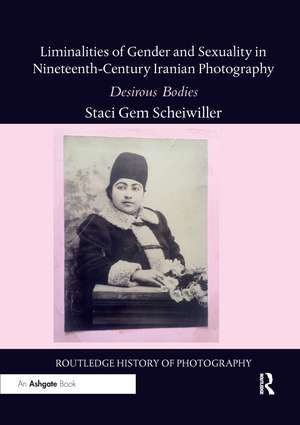Liminalities of Gender and Sexuality in Nineteenth-Century Iranian Photography: Desirous Bodies: Routledge History of Photography
Autor Staci Gem Scheiwilleren Limba Engleză Paperback – 30 sep 2021
| Toate formatele și edițiile | Preț | Express |
|---|---|---|
| Paperback (1) | 295.69 lei 6-8 săpt. | |
| Taylor & Francis – 30 sep 2021 | 295.69 lei 6-8 săpt. | |
| Hardback (1) | 852.22 lei 6-8 săpt. | |
| Taylor & Francis – 7 dec 2016 | 852.22 lei 6-8 săpt. |
Din seria Routledge History of Photography
-
 Preț: 311.37 lei
Preț: 311.37 lei - 9%
 Preț: 1037.99 lei
Preț: 1037.99 lei -
 Preț: 312.54 lei
Preț: 312.54 lei -
 Preț: 314.34 lei
Preț: 314.34 lei -
 Preț: 312.34 lei
Preț: 312.34 lei -
 Preț: 311.03 lei
Preț: 311.03 lei -
 Preț: 304.04 lei
Preț: 304.04 lei -
 Preț: 296.22 lei
Preț: 296.22 lei -
 Preț: 311.41 lei
Preț: 311.41 lei - 20%
 Preț: 259.51 lei
Preț: 259.51 lei - 19%
 Preț: 246.84 lei
Preț: 246.84 lei -
 Preț: 325.06 lei
Preț: 325.06 lei - 26%
 Preț: 850.73 lei
Preț: 850.73 lei - 16%
 Preț: 261.33 lei
Preț: 261.33 lei - 17%
 Preț: 259.90 lei
Preț: 259.90 lei - 15%
 Preț: 267.41 lei
Preț: 267.41 lei - 25%
 Preț: 766.49 lei
Preț: 766.49 lei - 16%
 Preț: 249.15 lei
Preț: 249.15 lei - 15%
 Preț: 258.97 lei
Preț: 258.97 lei - 16%
 Preț: 260.54 lei
Preț: 260.54 lei -
 Preț: 290.15 lei
Preț: 290.15 lei - 25%
 Preț: 713.72 lei
Preț: 713.72 lei - 30%
 Preț: 794.48 lei
Preț: 794.48 lei - 30%
 Preț: 776.19 lei
Preț: 776.19 lei -
 Preț: 326.56 lei
Preț: 326.56 lei - 17%
 Preț: 257.03 lei
Preț: 257.03 lei - 16%
 Preț: 260.16 lei
Preț: 260.16 lei -
 Preț: 326.26 lei
Preț: 326.26 lei - 18%
 Preț: 948.71 lei
Preț: 948.71 lei
Preț: 295.69 lei
Nou
Puncte Express: 444
Preț estimativ în valută:
56.59€ • 58.86$ • 46.72£
56.59€ • 58.86$ • 46.72£
Carte tipărită la comandă
Livrare economică 14-28 aprilie
Preluare comenzi: 021 569.72.76
Specificații
ISBN-13: 9781032179308
ISBN-10: 1032179309
Pagini: 240
Ilustrații: 122 Illustrations, black and white
Dimensiuni: 174 x 246 x 13 mm
Greutate: 0.39 kg
Ediția:1
Editura: Taylor & Francis
Colecția Routledge
Seria Routledge History of Photography
Locul publicării:Oxford, United Kingdom
ISBN-10: 1032179309
Pagini: 240
Ilustrații: 122 Illustrations, black and white
Dimensiuni: 174 x 246 x 13 mm
Greutate: 0.39 kg
Ediția:1
Editura: Taylor & Francis
Colecția Routledge
Seria Routledge History of Photography
Locul publicării:Oxford, United Kingdom
Public țintă
Postgraduate and UndergraduateCuprins
- Introduction: Locations of Desire
- A Language of Its Own: Depictions of Women in Iranian Art Before and Shortly After the Arrival of Photography
- Corporeal Politics: Constructions of Gender and Power in the Royal Nasiri Photograph Albums and the Photography of the Constitutional Revolution (1905-11)
- Collecting Women
- The Erotic Spaces of Qajar Photography
- For the Male Gaze: Depictions of Masculinity and Sexuality
- Enslaved Bodies of Desire: Photographs of Black African Slaves
- Conclusion: The Inevitable Witness
Notă biografică
Staci Gem Scheiwiller is Assistant Professor of Modern Art History at California State University, Stanislaus. Her publications include a co-edited volume with Markus Ritter entitled The Indigenous Lens: Early Photography in the Near and Middle East (2017) and the edited volume Performing the Iranian State: Visual Culture and Representations of Iranian Identity (2013).
Recenzii
"The subject is fascinating and the book is rewarding. ... [Scheiwiller's] careful and detailed descriptions of the illustrations and the copious and thoroughly documented captions admirably place the examples within the history of Iranian stylistic deveopments, political history, religion, and literature."
--Woman's Art Journal
"Scheiwiller provides a significant intervention into the field of Qajar photographic history and serves as a timely and substantial addition to the growing corpus of analyses of gender and sexuality in modern Iran....Reading this book and its images is both edifying and thought provoking; the questions it forces us to confront carry resonances far beyond the area of Iranian studies, with repercussions for how we understand gender and sexuality and the postcolonial more fundamentally."
--Art and Vernacular Photographies in Asia
--Woman's Art Journal
"Scheiwiller provides a significant intervention into the field of Qajar photographic history and serves as a timely and substantial addition to the growing corpus of analyses of gender and sexuality in modern Iran....Reading this book and its images is both edifying and thought provoking; the questions it forces us to confront carry resonances far beyond the area of Iranian studies, with repercussions for how we understand gender and sexuality and the postcolonial more fundamentally."
--Art and Vernacular Photographies in Asia
Descriere
This book examines Qajar Iran (1785-1925) as an ocular-centered society founded on what was seen and unseen, in the context of increasing modernization and global contact during the nineteenth and early twentieth centuries.
